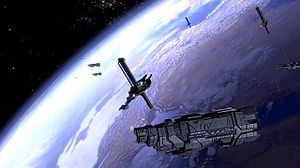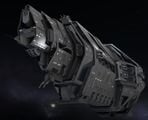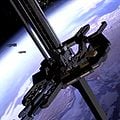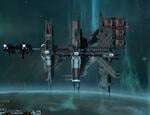UNSC Navy
From Halopedia, the Halo wiki
| UNSC Navy | |
|---|---|

| |
|
Formed: |
|
|
Affiliation: |
|
|
Branch: |
|
|
Nicknames: |
Swabbies[1] |
|
Engagements: |
|
|
Commanders: |
|
The UNSC Navy is the branch of the UNSC Defense Force responsible mostly for naval operations in space, though they still operate in the oceans with their terrestrial arm. Its roles include ship-to-ship combat; orbital bombardment; the deployment of atmospheric and space fighters, and the delivery of UNSC Marines into combat.
History
Formation
- Main article: Interplanetary War
The UNSC Navy was created during the Interplanetary War of the 2160's - precisely during the Argyre Planitia Campaign of 2163, as a result of the United Nations' need to oversee and monitor marine deployments from space, thus forming the United Nations Space Command. After the UN's victory in that war, the UNSC Navy became involved in colonization, the settling of minor trade disputes, and anti-piracy operations as humanity spread through space.[2]
The Insurrection
- Main article: Insurrection
Such low-level operations continued until the Insurrection, which forced the Navy to develop a modern space warfare doctrine. Beginning with the Callisto Incident of 2494, the UNSC Navy was involved in a series of small but important actions against Insurrectionists across human space.[3] The clandestine activities of the Office of Naval Intelligence also proved to be particularly useful in dealing with Insurrectionists during Operation: TREBUCHET.[4]
The lessons learned from the space engagements of the Insurrection may have contributed to the UNSC's eventual victory in the Human-Covenant War. From the Insurrection came the Magnetic Accelerator Cannon, titanium-A armor, and advances in ship-to-ship warfare tactics, all of which would prove crucial in humanity's fight against the Covenant. Furthermore, the Insurrection also saw the beginning of the career of Preston J. Cole, who would make an enormously decisive commitment to the Human-Covenant War.[5]
Human-Covenant War
- Main article: Human-Covenant War
Prior to the Human-Covenant War, the UNSC Navy had a large fleet of warships, including many capital ships and single-ship craft. However, beginning with the near-total destruction of the CMA's Battlegroup 4 at the First Battle of Harvest, followed by the loss of thirteen out of forty ships at the Second Battle of Harvest, the UNSC Navy sustained heavy losses of matériel and personnel throughout the war against the Covenant. Going on the offensive from 2526 to 2543, the bulk of the UNSC Navy under Admiral Preston J. Cole fought a series of victorious but enormously costly actions against the Covenant Navy.[6]
At the Battle of Alpha Aurigae in the Origami Asteroid Field in October 2526, a total of 117 UNSC vessels defeated the Covenant's twelve (at least three of which were Assault Carriers) but thirty-seven UNSC ships were lost. The Battle of XI Boötis A in 2528 saw the loss of thirty ships out of the UNSC's seventy to the Covenant.[7] The Battle of the Great Bear at the Groombridge 1830 system in 2530 saw eleven destroyers out of the fleet of seventeen destroyed by three enemy ships.[7]
By 2536, the Covenant had begun to encroach on humanity's Inner Colonies. In 2543, the UNSC Navy scored one final offensive victory against the Covenant at the Battle of Psi Serpentis, though at the cost at the apparent death of Preston Cole.[8]
In 2552, the Navy scored a morale-boosting victory at Sigma Octanus IV, but this was quickly offset by the crippling military losses of the Fall of Reach. The Navy lost over a hundred ships, including irreplaceable cruisers and supercarriers such as the UNSC Basra, UNSC Trafalgar, and the UNSC Musashi.[9][10] In the same year, a very large portion of its remaining ships were lost when the Prophet of Truth's military forces occupied Earth.[11] As a result, the UNSC Navy was only able to make a contribution of three frigates to the Battle of Earth and the Battle of Installation 00, with the Covenant separatists' navy handling most of the space fighting.[12]
Post-war
In the aftermath of the Human-Covenant War, the Office of Naval Intelligence began operations to sow dissent amongst the Sangheili and the remaining Covenant separatists, disregarding their wartime alliance in the hopes of rendering them unable to fight should they become a threat again. Among this operation's effects was the beginning of the Sangheili civil war and the establishment of a Covenant remnant led by Jul 'Mdama.[13]
In early 2553, the Navy launched its most powerful warship, the UNSC Infinity, though she would not be officially commissioned for another four years. Built in secret using technology recovered from Forerunner and Covenant sources during the war, the Infinity is the UNSC's largest and most advanced warship to date.[14] In March 2553, she secretly intervened in the Sangheili civil war, and demonstrated the UNSC's new technical capabilities by easily destroying the Covenant destroyer Defender of Faith.[15]
In 2557, the Infinity distinguished herself during the First Battle of Requiem and the recovery of Master Chief Petty Officer John-117. The UNSC Navy's forces around Earth had also been rebuilt, and the Home Fleet defended the planet against the Didact when he arrived with the intention of digitizing all of humanity with the Forerunner weapon known as the Composer. Earth's orbital platforms and Home Fleet Battlegroup Dakota had little to no effect against the Didact's ship, the Mantle's Approach, but the Infinity managed to damage the ship, allowing John-117 to enter using an F-41 Broadsword and destroy the ship with a HAVOK tactical nuclear weapon. This was the first space engagement of the Human-Promethean war, which continued six months later with the Infinity's second expedition on Requiem.[16]
Organization
Command and control
- Main article: UNSC Naval Command
The UNSC Navy is subordinate to the UNSC High Command (HIGHCOM). The Navy is administered by the UNSC Naval Command, or NAVCOM, headed by the Chief of Naval Operations, which in 2553 was Fleet Admiral Lord Hood. The CNO is assisted by the Deputy Chief of Naval Operations.[17] NAVCOM is split into three commands; Fleet Command, or FLEETCOM, has oversight of ship deployment, mission structures, and space operations, including the transport of troops and naval fighter operations. Logistical Operations Command, or NavLogCom, oversees the construction, maintenance, and distribution of supplies and materiél, including ships, ammunition, replacement parts, and food. Naval Special Warfare Command, or NAVSPECWARCOM, and Naval Special Weapons (NAVSPECWEP) are responsible for all Naval special operations, including deployments of SPARTAN-IIs.[18]
The Office of Naval Intelligence is technically subordinate to the UNSC Naval Command. In practice, however, ONI's activities extend far beyond intelligence gathering, and often receives mandates and directives from HIGHCOM or even higher.[18]
Commanding positions in NAVCOM tend to be held by Admirals.[17][19][20] Because of their role as an "amphibious", space-deployed force, the UNSC Marine Corps enjoys a close relationship with the Navy, with Marine complements being deployed on most warships.[21][19][22]
Operating forces
- Main article: UNSC fleet
UNSC Navy forces are divided into a number of fleets. These tend to be large formations, though they seldom patrol together; single ships are commonly seen patrolling throughout UNSC space.[22] More common tactical formations are battle groups, which are formed on an as-needed basis and vary dramatically in size from three ships to large carrier groups.[23][24][20][25]
Seaborne forces
Into the 26th century, the UNSC Navy continued to use maritime ships to patrol the seas. Little is known about this Naval arm. It is known, however, that Earth and the fortress world of Reach had bases for it. Other than that, it is known that the Navy possessed numerous aircraft carriers with full complements of F-99 Unmanned Combat Aerial Vehicles, suggesting that they were constantly kept at a high level of alert.
Other than participating to some extent during the Battle of Mombasa, the wet Navy was likely involved with a mission to the Yucatan Peninsula, where the SPARTAN Blue Team attacked a Covenant excavation force under the Gulf of Mexico.
Personnel
Large numbers of men and women are employed by the UNSC Navy. Servicepeople hold ranks, which are divided between officers and enlisted. UNSC Navy personnel are given training in self-defense. All crewmen are trained to use the M6 series of handguns.[26] Naval personnel are sometimes referred to as "swabbies", which can be a joke or a sign of disrespect.[1][27] A full list of Naval personnel can be found here. For a list of ranks within the UNSC Navy, see UNSC Navy Ranks.
UNSC Navy personnel wear distinctive uniforms for identification, comfort, and practicality. Dress uniforms are worn on formal occasions, such as ceremonies and other official functions,[19] while service and working uniforms are the basic uniform worn by UNSC Naval personnel while on duty.[28][29]
Equipment
Weapons
The primary offensive armament of UNSC spacecraft is the Magnetic Accelerator Cannon (MAC). These are high velocity coil guns that are used to accelerate projectiles ranging in mass from 600 metric tons in the case of smaller warships, and 3,000 tons in the case of Super MAC platforms. These projectiles are composed of titanium, depleted uranium, or tungsten with a ferrous core. "Super MAC" Orbital Defense Platforms accelerate MAC rounds to "point four-tenths"[30] the speed of light, around 12,000 kilometers per second, with twenty-three linear accelerator coils, while ship-based MACs have a lower velocity. Super MAC platforms can also reload a round in 5 seconds, where as ships will need several minutes to charge their MAC coils.
The UNSC frigate Gettysburg is quoted as firing a 600 ton shell at 30 kilometers per second.[31] Before Reach fell, the UNSC Pillar of Autumn was equipped with a modified MAC that could quickly fire three lighter projectiles in succession instead of just one heavier projectile. It was originally intended to allow the Pillar of Autumn a better chance of disabling a Covenant ship, which was a feature required for a mission that was later scrubbed following the Fall of Reach.
Almost all UNSC warships are equipped with M58 Archer missile pods for ship-to-ship engagements, which prove most effective against unshielded targets. A common tactic among UNSC ships is to disable the target's shields with MAC rounds and then pummel it with Archer missiles. UNSC ships in 2525 carried fusion missiles as an offensive weapon. They seem to have been removed or replaced in later years. UNSC ships may also carry Shiva-class nuclear missiles. In addition, the UNSC mounts 50mm auto-cannons on its ships for defense against enemy fighters and boarding craft, controlled by shipboard AIs.
UNSC warships also carry significant Marine detachments for internal security, boarding actions, and planetary assault, and carry all the equipment and matériel needed by Marine forces. It is implied that a significant portion of the interior of UNSC warships are devoted to this purpose, as there are armories and barracks that hold these supplies.
Ships of the UNSC Navy also carry a number of GA-TL1 Longsword interceptors. These are armed with 110mm rotary cannons and ASGM-10 missiles, and sometimes a Moray space mine system or even a single Shiva-class nuclear missile. They can also be remotely-operated and used to carry a remotely-detonated Shiva missile, which, when detonated, effectively destroys both the Longsword and its selected target.
Despite all of this firepower, however, UNSC warships during the Human-Covenant War had great difficulty in defeating Covenant ships even with a numerical advantage. It typically took multiple hits from a ship-based MAC weapon to disable a Covenant ship's shields, although larger, ODP-based "Super MACs" fire a round that can literally shatter Covenant capital ships.[32] Archer missiles had to be used in tremendous volumes to breach Covenant shield systems. Even with their shields down, Covenant ships have been noted to remain operational after multiple direct hits from normal MAC rounds. This advantage in firepower and shielding gave the Covenant an effective 3:1 ratio and better against UNSC ships as of the Human-Covenant War.
Ships
UNSC Navy vessels are typically armoured with Titanium-A armor. The largest vessels of the UNSC fleet are carriers and supercarriers.[22] While possessing weapons of their own, their primary role is to deploy fightercraft such as the GA-TL1 Longsword, and may serve as flagships in fleet actions.[20] If a carrier is unavailable, however, then heavily-armed and armored cruisers may fill this role.[22] The UNSC Navy has operated three classes of cruiser; the Marathon-class heavy cruiser, the Valiant-class super-heavy cruiser, and the now-obsolete Halcyon-class light cruiser.
UNSC destroyers and frigates are used for escorting larger cruisers and carriers, as well as for independent patrol and scouting operations. Both are roughly the same size, but destroyers are designed with greater emphasis on firepower and armor over versatility.[33][34] Frigates are multi-purpose warships that are used in a broad range of roles, ranging from heavy air support to fighter escort and fleet engagements. Some UNSC frigates are equipped with a sizable cargo bay for larger dropships and armor complements. The UNSC has also employed light frigates equipped with stealth systems in a specialized reconnaissance role.[35]
The Navy maintains a wide variety of smaller craft and support ships. These include prowlers for electronic intelligence gathering, refit stations, exfiltration craft, shuttles, and corvettes. Corvettes are notable as being one of the fastest ships in the UNSC Navy,[36] and a number of sub-classes have been developed including the Mako-class[37] and the fast-attack corvette.[38]
At least some UNSC ship production is handled by the Reyes-McLees Shipyards over Mars, though this may no longer be true due to the Covenant invasion of the Sol System in 2552.
Space fighters
Space fighters are small, maneuverable spacecraft, often used for bombing or "dog fighting" in space or in an atmosphere. The UNSC Navy operates a number of fighters, the most common of which is the GA-TL1 Longsword. The Longsword is a multi-role fighter that can be used in a variety of missions, including ground support, anti-ship attacks, and combat with other fighters.[39][40][22]
The F-41 Broadsword is a multirole space fighter in use after the Human-Covenant War. Like the Sabre, the Broadsword is equipped with energy shielding that covers the entire fighter and recharges when depleted. However, these shields are not rated for slipspace travel. The Broadsword is equipped with two M1075 ASW/AC 35mm MLA cannons and two M6088 ST/MMP missile pods. The fighter can also be equipped with a single piece of heavy ordnance, such as a HAVOK warhead.
A less common UNSC fighter is the OF92/EVA "Booster Frame". The Booster Frame is an experimental fighter developed as a prototype. They are specifically designed for extra-vehicular activity and special operations roles, dropped from hooks within the hangars of specialized UNSC ships. The fighter itself has no sealed cockpit, so a pressurized suit must be worn in order to operate the vehicle.[41][42]
Identified UNSC vessels and stations
Vessels
Carriers
|
Cruisers
|
Destroyers
|
Frigates
|
Prowlers
|
Corvettes
|
Colony ships
|
Command Ships
|
Other ships
|
Civilian craft in temporary commission
|
Stations
Orbital Defense Platforms
Other orbital facilities
|
Mobile stations
Remote scanning outposts
|
Medical stations
|
Trivia
As with the rest of the UNSC military, the structure and many of the traditions in the UNSC Navy are based on those in the United States Navy.
Gallery
- UNSC Savanah.jpg
A Paris-class heavy frigate during the Fall of Reach.
- Forward into dawn.jpg
The Forward Unto Dawn, a Charon-class light frigate flies over Installation 00.
The Marathon-class cruiser was one of the most powerful vessels in the entire UNSC fleet.
Its predecessor was the underarmed Halcyon-class cruiser, although updated ones like the Pillar of Autumn could outperform it.
The most powerful non-nuclear weapon in the entire UNSC, an orbital defense platform could destroy Covenant ships in a single round.
The UNSC Cradle, a specialized refit station capable of slipspace travel, takes the offensive in the Battle of Sigma Octanus IV.
A prowler, one of many such vessels forming the Navy's reconnaissance division.
A Phoenix-class colony ship, now refitted as massive armor and personnel carriers for use on the frontlines.
A classification of various designs, the UNSC destroyer is an effective escort for high-priority vessels such as fleet carriers and cruisers.
- UNSC Heracles.png
The UNSC Heracles, a destroyer, the first human vessel to survive an encounter with the Covenant in 2525.
- Legends ship 1.png
An Unidentified UNSC destroyer of unknown type during its mission against the Covenant on Heian.
- UNSC Infinity.jpg
The UNSC Infinity, the UNSC's postwar flagship and among the first vessels to employ reverse-engineered Forerunner technology.
- Dakota 4.jpg
Ships of Battlegroup Dakota engaged in the Battle of Earth in 2557.
- Dakota 3.jpg
A trio of vessels from Battlegroup Dakota take part in the Battle of Earth.
- Dakota 1.jpg
Another vessel of Battlegroup Dakota during the Battle of Earth.
List of appearances
Sources

|
Check out our collection of quotes related to UNSC Navy on its quotes page. |
- ^ a b Halo: The Flood, page 100
- ^ Halo: Evolutions - Essential Tales of the Halo Universe, "The Impossible Life and the Possible Death of Preston J. Cole", page 436
- ^ Halo: Evolutions - Essential Tales of the Halo Universe, "The Impossible Life and the Possible Death of Preston J. Cole"
- ^ Halo: Contact Harvest
- ^ Halo: Evolutions - Essential Tales of the Halo Universe, "The Impossible Life and the Possible Death of Preston J. Cole", page 457
- ^ Halo: Evolutions - Essential Tales of the Halo Universe, "The Impossible Life and the Possible Death of Preston J. Cole"
- ^ a b Halo: Evolutions - Essential Tales of the Halo Universe, The Impossible Life and the Possible Death of Preston J. Cole, page 470
- ^ Halo: Evolutions - Essential Tales of the Halo Universe, "The Impossible Life and the Possible Death of Preston J. Cole"
- ^ Halo: The Fall of Reach
- ^ Halo: First Strike
- ^ Halo 3
- ^ Halo 3
- ^ Halo: Glasslands
- ^ Halo: Glasslands, pages 421-422
- ^ Halo: The Thursday War page 303
- ^ Halo 4
- ^ a b Halo: First Strike
- ^ a b Halo Encyclopedia
- ^ a b c Halo 2
- ^ a b c Halo: Ghosts of Onyx
- ^ Halo: Combat Evolved
- ^ a b c d e Halo: The Fall of Reach
- ^ Halo Wars: Genesis
- ^ Halo Graphic Novel, page 86
- ^ Halo: Evolutions, "The Impossible Life and Possible Death of Preston J. Cole"
- ^ Halo: Combat Evolved, campaign level The Pillar of Autumn
- ^ Halo: First Strike, page 92
- ^ Halo: Contact Harvest, page 322
- ^ Halo 2 campaign level Delta Halo
- ^ Halo: The Fall of Reach, page 320
- ^ Halo: The Fall of Reach, page 108
- ^ Halo: The Fall of Reach, page 297
- ^ Halo: The Fall of Reach, page 139
- ^ Halo: Evolutions - Essential Tales of the Halo Universe, "Midnight in the Heart of Midlothian"
- ^ Halo: The Cole Protocol, page 35
- ^ Halo: Ghosts of Onyx, page 213
- ^ Halo: The Fall of Reach, page 85
- ^ Halo: Contact Harvest, page 60
- ^ Halo: The Essential Visual Guide, page 112
- ^ Halo: Reach
- ^ Halo Waypoint, Gauss Technology article
- ^ Halo Waypoint, Booster Frame article












